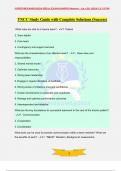©PREP4EXAMS@2024 [REAL-EXAM-DUMPS] Monday, July 29, 2024 12:15 PM
TNCC Study Guide with Complete Solutions (Success)
What roles are vital to a trauma team? - ✔️✔️1. Patient
2. Team leader
3. Core team
4. Contingency and support services
What are the characteristics of an effective team? - ✔️✔️1. Clear roles and
responsibilities
2. Shared mental model
3. Optimize resources
4. Strong team leadership
5. Engage in regular discipline of feedback
6. Strong sense of collective trust and confidence
7. Create mechanisms to cooperate and coordinate
8. Manage and optimize performance outcomes
9. Interdependent and adaptive
What are the key foundations to successful teamwork in the care of the trauma patient?
- ✔️✔️1. Communication
2. Cooperation
3. Coordination
What tools can be used to promote communication within a team member? What are
the benefits of each? - ✔️✔️1. *SBAR:* Situation, Background, Assessment,
1
,©PREP4EXAMS@2024 [REAL-EXAM-DUMPS] Monday, July 29, 2024 12:15 PM
Recommendations-To provide a framework for communication among members of the
healthcare team
2. *DESC:* Describe the specific situation or behavior, Express your concerns or how
the situation makes you feel, Suggest alternatives and seek agreement, state
Consequences in terms of impact on performance goals-Used in conflict management,
paraphrasing the other person's comments is an important technique that should be
done throughout the DESC support
3. *CUS:* I am Concerned, I am Uncomfortable, This is a Safety issue/I am Stressed-
Used to "stop the line" if a team member senses or discovers an essential safety breach
Kinematics - ✔️✔️The study of energy transfer as it applies to identifying actual or
potential injuries
Biomechanics - ✔️✔️The general study of forces and their effects
Mechanism of Injury - ✔️✔️How external energy forces in the environment are transferred
to the body
Newton's First Law of Motion - ✔️✔️A body rest will remain at rest, and a body in motion
will stay in motion
Newton's Second Law of Motion - ✔️✔️Force = mass x acceleration
Newton's Third Law of Motion - ✔️✔️For every action, there is an equal and opposite
reaction
Law of Conservation of Energy - ✔️✔️Energy can neither be created nor destroyed, but
can change form
Describe how Newton's Laws of Motion and the Law of Conservation affect energy
transfer in traumatic injury, and give an example - ✔️✔️-1st: weight and speed are
2
,©PREP4EXAMS@2024 [REAL-EXAM-DUMPS] Monday, July 29, 2024 12:15 PM
reasonable substitutions for mass and velocity, higher mass and/or higher speed
delivers greater energy
-2nd: an object's velocity changes when it is subjected to an external force; heavier
objects require more force to accelerate (or decelerate) them
-3rd:
-Conservation:
Ex: pot vs. child
-1st: the force of gravity holds the pot on the flat stovetop until energy is transferred to
the pot, such as by a toddler, grabbing the handle.Once the pot is in motion, it will
sustain its motion until interrupted by another force. As the pot strikes the child in the
head, the strength of bone imposes a force of resistance upon impact, thereby changing
the directional path of the pot. The stationary head stays in a fixed position until a
volume of energy adequate to move the head is transferred to it. This concept of
movement-energy transfer-countermovement applies to all mechanical traumas
-2nd: the pot continues to fall at a steady rate unless it is acted on by an outside force (a
hand pushing it out of the way or catching it)
-3rd: the transfer causes a redirection of the pot and movement of the head, as well as
energy absorption causing anatomic changes to the tissue that received the energy
transfer
-Conservation: energy is not created, nor it is destroyed at the site where the pot
impacts the head. Instead, energy is transferred from the kinetic (moving) object to the
object being impacted
What are the five forms in which energy exist? - ✔️✔️1. *Mechanical:* energy transfer
form one object to another in the form of motion
2. *Thermal:* energy transfer of heat in the environment to the host
3
, ©PREP4EXAMS@2024 [REAL-EXAM-DUMPS] Monday, July 29, 2024 12:15 PM
3. *Chemical:* heat energy transfer from active chemical substances, chlorine, drain
cleaner, acids, or plants
4. *Electrical:* energy transfer from light socket, power lines, or lightning
5. *Radiant:* energy transfer from blast sound waves, radioactivity such as a nuclear
facility, or rays of the sun
Differentiate between internal and external forces of energy transfer in the context of
trauma - ✔️✔️*External forces:*
-Can be exerted on the body by deceleration, acceleration, compression forces
-Deceleration forces include those applied in falls and collisions where injuries are
cause by a sudden stop in the body's motion
-Acceleration forces are not as common as deceleration forces and result from a
sudden and rapid onset of motion, like a parked car that is hit y vehicle traveling at the
high rate of speed
-Compression force is an external force applied at time of impact, like stationary
objects-dashboards or steering wheels that collide with or push up into a person.
Objects in motion-bullets, stabbing, bats, balls, fists and feet, or heavy falling objects
-Blast forces
*Internal forces:*
-Stress describes the internal force that resists the applied external force
-Stress is exerted on the body as tissues and organs change their dimensions
-Body tissues respond differently to energy impact, and the capacity to withstand energy
transfer is based on the characteristics, combined with biomechanics and MOIs
-The strength of bone varies and can be augmented by adjacent muscle systems
-Solid organs tolerated pressure-wave energy better than air-filled organs
4




